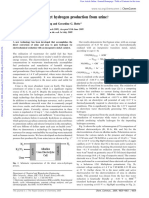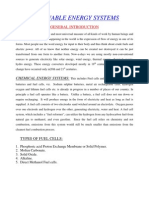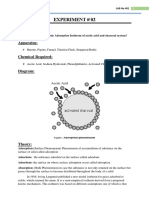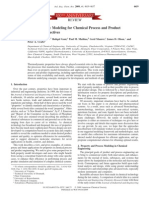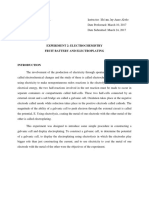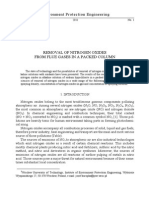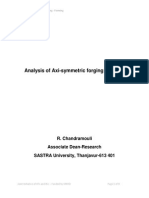Theory of Electrolysis
Theory of Electrolysis
Uploaded by
Adarsh ChoudharyCopyright:
Available Formats
Theory of Electrolysis
Theory of Electrolysis
Uploaded by
Adarsh ChoudharyCopyright
Available Formats
Share this document
Did you find this document useful?
Is this content inappropriate?
Copyright:
Available Formats
Theory of Electrolysis
Theory of Electrolysis
Uploaded by
Adarsh ChoudharyCopyright:
Available Formats
Int. J. Electrochem. Sci.
, 7 (2012) 3314 - 3326 International Journal of
ELECTROCHEMICAL SCIENCE
www.electrochemsci.org
Review
Electrical Efficiency of Electrolytic Hydrogen Production
Kaveh Mazloomi1,*, Nasri b. Sulaiman1, Hossein Moayedi2
1
Department of Electrical and Electronic Engineering, Faculty of Engineering, University Putra Malaysia 2 Department of Civil Engineering, Estahban Branch, Islamic Azad University, Estahban, Iran * E-mail: kavehoo@yahoo.com Received: 12 January 2012 / Accepted: 6 March 2012 / Published: 1 April 2012
Common industrial electrolyzers have a nominal hydrogen production efficiency of around 70%. High power dissipation value is the most important drawback of such systems since electric power expense has the largest share in the price of electrolytic hydrogen. The electrical impedance of an electrolysis cell causes a fraction of the applied energy to be wasted as heat while the electric current passes through it. As the prior publications show, many efforts are made to reduce this effect. According to the available literature, several internal and external variables are pointed out to have an influence on the electrical behavior of such cells. This paper provides an insight to these factors in regards to minimize the energy loss of the process of water electrolysis.
Keywords: Water electrolysis, Hydrogen production, Electrical power, Efficiency, power dissipation
1. INTRODUCTION Electrolytic hydrogen production has been scientifically studied for more than a century [1, 2]. According to the literature, hydrogen has been used by for military, industrial and commercial purposes since late 19th century [3]. Nowadays, electrolytic hydrogen has a share of only 4% [4, 5] in the global production of the most abundant element of the universe [6, 7]. Electricity expense constitutes the largest fraction of hydrogen production costs [9]. High hydrogen production expenses count as the main deficiency of commercial and industrial electrolyzers. Hence electrolytic methods are usually outperformed by other approaches such as steam methane reformation. An electrolyzer is usually subjected to massive current values in order to break the water molecules into oxygen and hydrogen. The reaction equation is noted as below: 2H2O 2H2 + O2 (1)
Int. J. Electrochem. Sci., Vol. 7, 2012
3315
Electrochemical decomposition energy of water is relatively high since water molecules have a stable structure at ambient temperature [8]. Approximately, a minimum voltage of 1.23V is required to be applied to a water molecule at laboratory conditions to break the bonds between hydrogen and oxygen atoms. This voltage is also known as the equilibrium voltage of water. However, much higher voltage levels are used in industrial electrolysis cells. The excess voltage is referred to as the overpotential of the process reaction [10]. The overpotential value is affected by different factors, which are going to be discussed in the following sections of this paper. In addition, by following the Ohms law (equation 2) the electric power can be calculated as in equation 3. U=RI P=UI (2) (3)
Where U is the electrical potential in volts, I is the electric current in Amperes, R is the electrical resistance in Ohms and P is the electric power in Watts. Obviously, for very large current levels, any slight increase of the cell voltage can cause a drastic raise in the power demand. Moreover, technical data show electrolyzers to usually perform their process under low voltage and high current level conditions. Massive current densities cause a noticeable value of unwanted ohmic voltage drop between the electrodes. As a result, formation of unwanted electrical power loss and less process efficiency values are inevitable. Many efforts are made in order to force an electrolysis cell to reach a certain current level by applying lower voltage levels to it. Major causes of the overvoltage requirement are introduced and discussed in the following sections of this paper. Moreover, possible modifications are pointed out in order to minimize the unwanted negative effects of each parameter.
2. FACTORS WITH AN INFLUENCE ON ELECTRICAL EFFICIENCY 2.1. Electrolyte quality Bases and acids are known to change the nonconductive nature of pure water. These compounds have a great reducing effect on the overvoltage value of an electrolyzer [11, 12] due they improve the ionic conductivity aqueous electrolyte compounds. However, the concentration level of acidic and alkali solutions are limited in practice due to the highly corrosive behavior of such materials. A 25% to 30% KOH aqueous solution is reported to have a wide use in electrolyzers [13]. On the other hand, the electrocatalytic performance of water electrolysis cell is known to be limited [14, 15]. This limitation is mainly cause the overall electrical resistance of a cell to rise and will cause the efficiency to fall. Therefore, substitute electrolytes such as ionic liquids have been introduced to improve the conductivity and stability factors of electrolytic baths [16, 17]. de Souza et al. [18] performed a series of experiments on the use of the ionic liquid of 1-butyl-3-methyl
Int. J. Electrochem. Sci., Vol. 7, 2012
3316
imidazolium-tetrafluoroborate (BMI.BF4) [19] in water at ambient temperature. The electrode plates of these cases were selected from a number of easily found metals such as carbon steel (CS), Nickel (Ni), Nickel-Molybdenum (Ni-Mo) alloy and Molybdenum (Mo). A maximum efficiency value of 96% was reported for the case of low carbon steel electrodes [20] in 10 vol.% aqueous solution of MBI.MF4. All tests took place at the current density value of 44mA cm-2. The reported efficiency levels of this research are much higher than the average 73% efficiency of common commercial and industrial electrolyzers [21]. However, it should be considered that such electrolyzers usually function at much higher current densities than the mentioned experimental value. Moreover, any existence of impurities may cause unwanted side reactions in an electrolysis cell [22]. Magnesium, chloride and calcium ions can be named as a few common examples of these impurities. In addition, contaminations can block and passivate the electrode plates and/or separator surfaces [11, 23] and sabotage the inter-electrode mass and electron transfer. The latter-mentioned is another formation cause for the excess ohmic resistance of the electric current path.
2.2. Temperature Temperature is known to be one of the most effective variables on the electric power demand of an electrolysis cell. Electrolysis process is much more efficient at raised temperatures [20]. The reasons of this behavior can be discussed according to the thermodynamic characteristics of a water molecule, as its splitting reaction potential is known to reduce as the temperature increases. Moreover, ionic conductivity and surface reaction of an electrolyte rise directly with temperature [24]. High temperature water electrolysis requires less energy to reach any given current density in analogy with a low temperature process [25, 26]. As a practical example of the latter, Bailleux [27] tracked the operation of a test hydrogen production plant for two years. Implemented plant technology of this case was much simpler back in early 1980s in contrast with current most recent electrolyzers. The case study plant of this report used a 40%wt potassium hydroxide alkaline solution as an electrolyte to be decomposed under the pressure, current density and temperature range conditions of 20bar, 10kA m -2 and 120C to 160 C respectively. Data scanners were used to monitor the mentioned parameters as well as the purity of the output gasses in order to determine the unwanted contents of oxygen and hydrogen outlets. The report shows a voltage reduction of 120mV as the temperature was raised from 120C to 150C. However, the increased temperature and pressure were mentioned to cause some stability problems such as container cracks and gasket leaks. In more recent experiments, high temperature electrolysis is referred to cases with much higher temperature ranges. As an example of such, we can mention a work of Mingyi et al. [28]. Their tests were conducted for the analysis of the electrochemical behavior and thermodynamic characteristics of a high temperature steam electrolyzer (HTSE). They expressed high temperature water electrolysis to need less energy than conventional low temperature electrolysis processes. More efficient process was observed as a result. Moreover, they divided the total electrolysis efficiency to three separate and individual factors of: electrical efficiency, electrolysis efficiency and thermal efficiency. They calculated the share of
Int. J. Electrochem. Sci., Vol. 7, 2012
3317
each parameter to be 70%, 22% and 8% respectively from the total efficiency. According to their discussion, increased cell temperature leads to a higher thermal and lower electrical efficiency values where the electrolysis efficiency remains without any significant changes. The authors also reported the possibility of coupling the HTSE device with a high temperature gas cooled reactor (HTGR). When the electrolysis temperature was increased to 1000C, an overall efficiency of the process of 59% was recorded which was remarkably higher than the 33% initial value. The process efficiency was stated to be more than twice of those of the conventional low temperature electrolyzers of the time. In addition, Ganley [29] studied the process efficiency of high temperature/ high pressure electrolyte solutions (steam state). The experiments were carried out in a chemical resistant container since the sample electrolyte was a highly concentrated KOH solution heated up to 400 C. During the studies, the electrolyte was subjected to different values of compression during the experimental work. The electrolyte concentration was set at 19 M at the starting phase of each experiment which is highly corrosive to many metals and alloys. Another varying condition of the experimental work was the electrodes material which is the subject of discussion in following sections. Lower voltage level was required to reach any given current density for temperatures between 200 C and 400 C. The results show that a voltage level of 1.8 V was enough to cause a current density of 200 mA cm -2 at 200 C. This value was only 1.5V when the electrolyte was heated up to 400 C at the same pressure and current density. As Nagai et al. [30] expressed, heat can reduce the reversible potential of water (also known as the equilibrium voltage). This parameter also enlarges the size of the gas bubbles and reduces their rising velocity. The latter-mentioned causes a larger void fraction in the electrolyte and decreases the efficiency as a result. The void fraction is the subject of discussion in section 2.3. In another case, Ulleberg [14] developed models for the process. Their thermodynamic and electrochemical models show noticeable cut downs in both over voltage and reversible potential of the heated cells. This expression is also supported by comparing the voltage versus current curves for both cases of low and high temperature electrolysis. They reported remarkably improved efficiency levels to be a resultant of conducting the electrolysis process in high temperatures. Conducting such processes in drastically high temperature levels on gas state electrolyte is expressed to be more efficient than the low temperature processes although, mechanical, stability and physical properties of such systems are still a concern for manufacturers and designers of industrial and commercial electrolyzers.
2.3. Pressure Appleby et al. [31] tried to lower the costs of hydrogen production by creating higher current density conditions in conventional electrolyzers According to their research, high pressure electrolytes will consume less power in the process of electrolytic decomposition. The main reason was stated to be the shrinking effect of pressure on the gas bubbles which cause the ohmic voltage drop and power dissipation to reduce. Moreover, high pressure electrolysis has less power demand for the phase of
Int. J. Electrochem. Sci., Vol. 7, 2012
3318
product compression. These experiments were conducted in a typical three compartment electrolyzer with a varying temperature between 25C and 90C. Cell current density was kept at 1 mA cm-2 with an electrolyte of either a 34%wt or 25%wt KOH solution in distilled water. The electrodes were chosen from pure platinum (99.99%) and smooth nickel (Ni 200) plates with a 1 cm2 surface area. Authors noted an overall voltage drop of up to 100mV when the conversion process was conducted at a pressure level of under 30 atm. No significant further voltage drop was recorded at higher pressure values (up to 40 atm). The cell voltage vs pressure graph has its highest reduction slope when the pressure was raised from 1atm to 10atm despite of the process temperature. Referring to a similar work, Onda et al. [32] calculated the energy consumption of compressing a liquid electrolyte to be much less than those of gas state hydrogen compression. These calculations were based on the results of an earlier research of LeRoy et al. [33]. They estimated the ideal temperature and pressure conditions for electrolytic hydrogen production to be around 70 MPa and 250 C relatively. High temperature and intense pressure will change both Gibbs energy and enthalpy levels of an electrolysis process. Hence, lower voltage level will be required as the temperature rises in high pressures and vice versa. However, in pressure levels higher than 20MPa, they found the voltage rise to be negligible. This behavior became more sensible at lower temperatures. Finally, an electrolysis efficiency enhancement of 5% was observed. Another 50% of energy was saved at the compression phase of high pressure electrolytic hydrogen production.
2.4. Electrical resistance of the electrolyte Electrical resistance of an object is an evaluation of its opposition to the passage of electric current. The level of this force is proportional to the cross section area and the length of the current path and the material resistivity of the conducting material. The relationship between the mentioned variables is shown in equation 4 as bellow. R= (4)
Where A is the cross section area, is the material resistivity, R is the electrical resistance, and l is the length of the current path. Inside and electrolysis cell, electrons start their travel from the surface of an electrode, move through the electrolyte and end their journey at the surface of the other electrode. We can assume the path as an object with the same length as the distance between electrodes, the cross section of the area of electrodes overlap and an equivalent resistivity value. The equivalent resistivity consists of different variables such as the electrodes resistivity, electrical admittance of the electrolyte and the reaction between electrodes surfaces and electrolyte. Hence, the equivalent resistivity is a function of the following variables:
Int. J. Electrochem. Sci., Vol. 7, 2012 2.4.1. Space between the electrodes
3319
According to equation 4, by reducing the distance between electrodes, lower electrical resistance can be obtained. However, the question may occur that how much proximity of electrode plates is practically possible? Nagai et al. [30] carried out a series of experiments to find the optimum space between electrodes. They examined the effects of the void fracture between electrodes which is caused by the formation of gas bubbles. These experiments were conducted at ambient pressure with Ni-Cr-Fe alloy electrodes in a 10%wt potassium hydroxide aqueous solution. They varied the current density, system temperature and the distance between electrodes, their size, wettability and inclination. The results clearly depict that placing the electrodes too close to each other will increase the value of the void fracture and will lead to a less efficient process. This phenomenon became more sensible at high current density levels. By placing the electrodes at different distances and comparing the result values of cell voltage and current, the authors concluded that positioning the electrodes too close to each other will decrease the process efficiency. LeRoy et al. [34] also reported the same effect. They expressed larger electrical resistance of an electrolyte is a result of gas bubbles accumulation in the inter-electrode area. Therefore, this accumulation will cause the process to be less efficient.
2.4.2. Size and alignment of the electrodes Another variable of equation 4 is the cross section area of an object. Less resistive current path is known to be a result of using electrodes with larger surface areas. Again, in this case, it would be useful to define the term larger surface area in more details. This definition will help us to know the practical dimension limits of an electrode plate? A series of experiments have been conducted in order to test the effects of using electrodes of different sizes on the process efficiency [30]. As the results show, at the same electrode width, larger electrode height will cause additional power dissipation in a cell. The reason was expressed to be the formation of a larger volume of void fraction. The models of gas bubbles movement [35] clearly depict larger amounts of bubble accumulation in higher parts of the electrodes. These experiments also show that higher efficiency levels can be obtained by placing the electrodes in a vertical position. The latter is caused by reduced ohmic resistance due to the optimum bubble departure rate.
2.4.3. Forcing the bubbles to leave Ohmic resistance in an electrolysis bath is related to the bubble coverage of all surfaces since gas bubble accumulation on each surface will reduce its conductivity. Hence, it causes a higher level of ohmic voltage drop [36]. On the other hand, bubbles diameter depends on the current density, temperature and pressure. Pressure value has an inverse correlation with the bubbles size where current density and temperature have an opposite affect it [37]. Moreover, the disengagement rate of gas
Int. J. Electrochem. Sci., Vol. 7, 2012
3320
bubbles from the surfaces and their departure velocity play a significant rule in the value of the electrical resistance of an electrolytic bath. Figure 1 justifies this subject. In this figure, the distance between electrodes l is broken into n smaller segments li. Equation 4 can be used to calculate the resistance for each partial length of li. The presence of gas bubbles significantly reduces the efficient cross section area for each li. Therefore, it increases the total value of R.
Figure1. The formation of void fraction
Hence, equation 4 could be re-written as bellow: R= ( li ) (5)
Equation 5 and figure 1 depict the effect of void fracture which has been discusses earlier. Many efforts are made to force the bubbles leave the cell environment. As an instance, De Li et al. [38] exposed their experimental electrolysis apparatus to an ultrasonic field in this regard. System efficiency and energy consumption were recorded in both cases of presence and absence of such field. Subjecting the electrolyzer to such fields caused a remarkable cell voltage reduction. The latter was more obvious in the cases of high current density and low electrolyte concentration. An improvement rate of 15% to 18% was observed in high current density experiments. Hence, the authors were able to achieve a maximum energy saving rate of 10% to 25%. Forcing the bubbles to Disengage from electrodes, membrane and electrolyte surface is known to improve the local mass and heat transfer as well as the process efficiency. Power consumption of the ultrasonic generator is expressed to be negligible in contrast with the power demand of the cell itself. A 0.05kW ultrasonic generator provided a field strong enough for a 100kA electrolysis cell. In this case, the field was able to deduct up to 30 kW from the total power demand of the system. Wang et al. [39] conducted another set of experiments to force the adsorbed gas bubbles on the electrodes and membrane surfaces to detach. They exposed the cell to a super gravity field in this regard. Super gravity condition was simulated by placing the cell in a centrifugal (rotating) installation. In this experiment cell temperature was maintained at 333 K throughout the process. High gravity acceleration environment is known to increases both velocities of convection flow and inter-phase slip [40]. Therefore, better multiphase separation in gas-liquid and gas-solid phases [41] is a result of
Int. J. Electrochem. Sci., Vol. 7, 2012
3321
subjecting an electrolysis cell to a super-gravity field. Such improved separation leads to easier gas bubble disengagement and faster departure from the electrolyte surface. Lower ohmic loss and over potential are the predicted result of this approach. Wang et al. [39] measured the required level of cell voltage to reach a given current density for different gravity conditions. The results show remarkably lower voltage levels for the cases with higher gravity values. The difference became more significant for increased current densities. Authors reported improved levels of efficiency for the cells which are performing under super gravity conditions. According to this report, a centrifuge installation with a nominal power of 3 kW was able to deduct up to 51 kW from the power demand of a 100 kA industrial electrolyzer.
2.5. Electrode material A wide range of materials are being used as electrodes. Each metal has a different level of activity, electrical resistance and corrosion resistivity. Platinum and gold are known to be two of the best choices for being used as electrodes. However, high prices limit their usage in industrial and commercial electrolyzers. Aluminum, Nickel, Raney nickel and cobalt are the most common electrode materials for being used in alkaline electrolytic baths. This popularity is the result of their satisfactory price range, corrosion resistance and chemical stability [21]. Appleby et al. [31] conducted a set of experiments by utilizing different electrodes such as 99.99% pure Ni, Pt, Ir and Rh as well as Ni cloth, Ni sinter, Ni-Cd and low impregnation Nickel and cobalt molybdate catalyst on nickel sinter. Each electrode was pre-anodized in order to obtain stable potential characteristics. The results express nickel to show more desirable potential characteristics among the mentioned materials. In addition, authors found woven or porous sintered electrodes to be 30 times more active those with a smooth surface. Larger electrode surface area causes an Apparent exchange current density. The latter is known to be the main reason of the excess observed activity. There is a wide range of variations in the value of electrode-electrolyte activity for different materials. For example, platinum electrodes show higher activity levels in contact with KOH aqueous solutions in comparison with molybdenum plates. Literature show utilization of 1-butyl-3methylimidazole tetrafluoroborate (BMI.BF4) ionic liquid will lead to exceptional efficiency levels for almost all electrode plates [18].
2.6. Separator material Placing a separator plate in a cell, blocks the free movement of mass and ions to some extent. Moreover, the presence of such barrier increases the void fracture by further accumulating of gas bubbles in the electrolyte [30]. In addition, the effective electrical resistance of a separator plate is frequently calculated to be as large as three to five times of those of the electrolyte solutions [42]. Electrical resistance of a separator depends on different variables such as corrosion, temperature and pressure [43]. Back in middle 1990s many scientists named asbestos to be the best choice for being used as a diaphragm due to its highly wettable and porous structure. These features
Int. J. Electrochem. Sci., Vol. 7, 2012
3322
cause a plate to show electrical resistance in practice [44] . However, asbestos is known to be a toxic and hazardous material [44-47]. These characteristics caused the researchers to start looking for substitute materials. Nowadays there are different materials and technologies available to reduce the negative electrical effect of separators [45, 46, 48-50].
2.7. Applied voltage waveform It is almost common for electrolysis systems to use a steady (Figure 2a) or smooth (Figure 2b) DC voltage to decompose an electrolyte.
Figure 2. (a) Steady DC voltage waveform. (b) Smooth DC voltage waveforms
Accoring to the Ohms law, applied DC voltage U causes the current I to pass through the electrolyte with the resistance of R (refer equation 2). Hence, the common method of current or current density regulation is by the application of a certain voltage to a cell. Shimizu et al. [51] conducted their experiment to test the behavior of a cell while the voltage was applied in the form of ultra short pulses. Their goal was to reach higher cell power (increase the gas production rate) without reducing the efficiency. They placed platinum electrode plates 3 cm apart from each other in a 1M KOH aqueous solution. Electrolyte temperature was maintained to 293 2 K throughout the experiment. The results were compared for the cases of using a conventional DC, and an ultra-short pulse power supply with an output pulse width of about 300 ns. Output frequency and peak voltage of this power supply were adjustable from 2 kHz to 25 kHz and 7.9 V to 140 V respectively. In the case of applying ultra-short pulses to an electrolysis cell, there will not be enough time for formation of stable double-layers or diffusion-layers. A formation period of 3 s is known to be required by the authors for diffusion-layers. Moreover, a pulse width of 3 ns is also much less than the time requirement of formation of a stable double-layer which is known to be not larger than several hundred milliseconds. A sample waveform of applied ultra short pulse is illustrated in figure 3.
Int. J. Electrochem. Sci., Vol. 7, 2012
3323
Figure 3. Ultra short pulse waveform
The production rate versus input power graph deviated more from the ideal graph as the input power was increased when the cell was subjected to a pure DC voltage. In addition, the efficiency was reduced significantly. As the authors mentioned, applying 0.25 Watts of power to the cell caused the process to be five times more efficient than the case with a consumption level of 250 Watts. Regarding to the literature, the utilization of an ultra-short pulse generator provided the possibility of subjecting the cell to higher power levels without causing any further energy loss. The latter is achievable if the power is regulated by adjusting the peak pulse voltage levels. Moreover, raised pulse frequency can deliver extra power to the cell without causing any significant effect on the efficiency. The authors mentioned a lower electron energy level caused by sharper pulse waveforms to be the reason of this behavior. However, the authors did not provide much information about any possible relation between the peak voltage and frequency regarding the process efficiency. Hence, we believe conducting further researches in this regard might lead to very interesting results. In another related research, Ursua et al. [52] characterized a commercial electrolyzer unit. The apparatus was able to handle the maximum electrical current and temperature values of up to 120 A and 65 C respectively. Two different types of voltage regulators were used to deliver the required energy to the system. Their objective was to analyze the behavior, efficiency and power consumption of the system with each power supply. The first voltage regulator was thyristor based. These regulators adjust their output voltage level by the means of controlling the switching times of a semiconductor device. The semiconductor switch is connected to the AC power line in series. This topology works at the same frequency of the input power line which is either 50Hz or 60Hz (varies by regional standards). Results show the cell to have a non-continues voltage and current waveform. Furthermore, an undesirable distribution of current harmonics was detected in the output waveform. A maximum efficiency of 70.9% could be achieved for this case. The tests were repeated with a transistor based power supply. This topology works at a much higher frequency (up to 100 kHz). In this case, the time ratio of conducting to cut-off ratio of a rapidly switching power transistor determines the amount of energy passing through the power supply
Int. J. Electrochem. Sci., Vol. 7, 2012
3324
unit. The load voltage or current is regulated as a result of this action where they usually have an almost pure DC wave form. In addition, the output harmonics of such units are negligible in contrast with those of thyristor based devices. A maximum efficiency rate of 77.6% was observed for the case of using the latter-described power supply. The results of this experimental work show a 10% more efficient conversion process by using a transistor based power regulator. Unfortunately, experiments on the pure electrical characteristic of electrolysis process are very rare to find. Electrical variables are very common for measuring the electrochemical characteristics of electrolytic baths. However, we believe more study is required to analyze the behavior of such cells as a pure electrical load in order to develop more reliable equivalent circuits. We should mention that the available equivalent circuits for electrochemical systems usually contain a few non-electrical components such as faradic impedances which are not easily analyzed by electrical approaches. Brad [53], and Armstrong and Henderson [54] Introduced very similar equivalent circuits for an electrolysis cell. These circuits consider the electrical impedance of the electrolysis system to be in a non-linear form. Existence of capacitive and faradic elements is the reason of such consideration. Moreover, it is more common to conduct the electrolysis process by applying a pure DC waveform to the cell which is suitable to test linear impedances and ohmic loads. Therefore, according to the mentioned equivalent circuits, the effect of applying other forms of voltage might lead to interesting and important findings.
3. CONCLUSION This study provides information about the physical, chemical and electrical propertied of water electrolysis cells with a view on their effects on the efficiency of the process. The possible modifications can be done on a cell in order to minimize its electrical power dissipation. a. High temperature and pressure processes are more efficient. These parameters can be raised as much as the physical strength of the apparatus allows. b. Utilization of highly concentrated electrolytes will lead to less impedance values. On the other hand, the use contaminated solutions cause side reactions to take place in the cell and will reduce the lifespan of the apparatus. c. Placing the electrodes in an absolutely vertical position at a certain distance from each other will reduce the ohmic resistance between them. Moreover, the utilization of metals with high degrees of activity and porous materials will enhance electric and ionic conductivity of the system. d. Forcing gas bubbles to detach from the electrode and separator surfaces and to leave the system will decrease the void fraction. Lower impedance and higher efficiency levels will be achieved as a result. e. Selecting the electrodes of larger sizes is an important factor for to enlarge their overlap surface area and therefor the current path. However, since gas bubbles will accumulate in higher altitudes of the cell, certain considerations are recommended to limit the height of the electrode plates. f. Since the equivalent circuit of a water electrolysis cell contains non-linear elements, more research is required to study the best method of power application to a cell.
Int. J. Electrochem. Sci., Vol. 7, 2012 References 1. 2. 3. 4. 5.
3325
J. W. Richards, Journal of the Franklin Institute, 152 (1901) 201. J. W. Richards, Journal of the Franklin Institute, 141 (1896) 192. J. W. Richards, Journal of the Franklin Institute, 160 (1905) 377. Seth Dunn, Worldwatch paper 157, august 2001, 3 (2002) 16. R. F. de Souza, J. C. Padilha, R. S. Gonalves, M. O. de Souza and J. Rault-Berthelot, J. Power Sources, 164 (2007) 792. 6. C. E. Gregorio Padro and F. Lau, ADVANCES IN HYDROGEN ENERGY. New York: Kluwer Academic Publishers, 2002. 7. University of Wisconsin. Periodic Table Live. Available: http://genchem.chem.wisc.edu/lab/ptl/ptl/Elements/h/H.html. 8. F. N. Lin, W. I. Moore and S. W. Walker, Int J Hydrogen Energy, 10 (1985) 811. 9. Ivy J. Summery of electrolytic hydrogen production: milestone completion report, NREL/MP-560 36734; September 2004. 10. H. Matsushima, T. Nishida, Y. Konishi, Y. Fukunaka, Y. Ito and K. Kuribayashi, Electrochim. Acta, 48 (2003) 4119. 11. P. Millet, F. Andolfatto and R. Durand, Int J Hydrogen Energy, 21 (1996) 87. 12. S. P. S. Badwal, S. Giddey and F. T. Ciacchi, Ionics, 12 (2006) 7. 13. Guttman F and Murphy OJ, Modern Aspects of Electrochemistry. New York: Plenum Press, 1983. 14. . Ulleberg, Int J Hydrogen Energy, 28 (2003) 21. 15. G. W. Crabtree, M. S. Dresselhaus and M. V. Buchanan, Phys Today, 57 (2004) 39. 16. C. Lagrost, D. Carri , M. Vaultier and P. Hapiot, Journal of Physical Chemistry A, 107 (2003) 745. 17. R. F. De Souza, J. C. Padilha, R. S. Gonalves and J. Dupont, Electrochemistry Communications, 5 (2003) 728. 18. R. F. de Souza, G. Loget, J. C. Padilha, E. M. A. Martini and M. O. de Souza, Electrochemistry Communications, 10 (2008) 1673. 19. R. F. De Souza, J. C. Padilha, R. S. Gonalves and J. Rault-Berthelot, Electrochemistry Communications, 8 (2006) 211. 20. V. M. Nikolic, G. S. Tasic, A. D. Maksic, D. P. Saponjic, S. M. Miulovic and M. P. Marceta Kaninski, Int J Hydrogen Energy, vol. In Press, Corrected Proof. 21. Z. D. Wei, M. B. Ji, S. G. Chen, Y. Liu, C. X. Sun, G. Z. Yin, P. K. Shen and S. H. Chan, Electrochim. Acta, 52 (2007) 3323. 22. K. Zeng and D. Zhang, Progress in Energy and Combustion Science, 36 (2010) 307. 23. C. Belmont, R. Ferrigno, O. Leclerc and H. H. Girault, Electrochim. Acta, 44 (1998) 597. 24. J. Udagawa, P. Aguiar and N. P. Brandon, J. Power Sources, 166 (2007) 127. 25. D. L. Stojic, M. P. Marceta, S. P. Sovilj and S. S. Miljanic, J. Power Sources, 118 (2003) 315. 26. Bockris JOM, Conway BE, Yeager E and White RE, Comprehensive Treatise of Electrochemistry. New York: Plenum Press, 1981. 27. C. Bailleux, Int J Hydrogen Energy, 6 (1981) 461. 28. L. Mingyi, Y. Bo, X. Jingming and C. Jing, J. Power Sources, 177 (2008) 493. 29. J. C. Ganley, Int J Hydrogen Energy, 34 (2009) 3604. 30. N. Nagai, M. Takeuchi, T. Kimura and T. Oka, Int J Hydrogen Energy, 28 (2003) 35. 31. A. J. Appleby, G. Crepy and J. Jacquelin, Int J Hydrogen Energy, 3 (1978) 21. 32. K. Onda, T. Kyakuno, K. Hattori and K. Ito, J. Power Sources, 132 (2004) 64. 33. R. L. LeRoy, C. T. Bowen and D. J. LeRoy, J. Electrochem. Soc., 127 (1980) 1954. 34. R. L. LeRoy, M. B. I. Janjua, R. Renaud and U. Leuenberger, J. Electrochem. Soc., 126 (1979) 1674. 35. P. Mandin, A. A. Aissa, H. Roustan, J. Hamburger and G. Picard, Chemical Engineering and Processing: Process Intensification, 47 (2008) 1926.
Int. J. Electrochem. Sci., Vol. 7, 2012
3326
36. K. Qian, Z. D. Chen and J. J. J. Chen, J. Appl. Electrochem., 28 (1998) 1141. 37. R. M. de Jonge, E. Barendrecht, L. J. J. Janssen and S. J. D. van Stralen, Int J Hydrogen Energy, 7 (1982) 883. 38. S. Li, C. Wang and C. Chen, Electrochim. Acta, 54 (2009) 3877. 39. M. Wang, Z. Wang and Z. Guo, Int J Hydrogen Energy, 35 (2010) 3198. 40. P. Mandin, J. M. Cense, B. Georges, V. Favre, T. Pauport , Y. Fukunaka and D. Lincot, Electrochim. Acta, 53 (2007) 233. 41. C. Ramshaw, Heat Recovery Systems and CHP, 13 (1993) 493. 42. Pickett DJ, Electrochemical Reactor Design. Amsterdam: Elsevier, 1979. 43. R. Renaud and R. L. LeRoy, Int J Hydrogen Energy, 7 (1982) 155. 44. V. M. Rosa, M. B. F. Santos and E. P. da Silva, Int J Hydrogen Energy, 20 (1995) 697. 45. J. Kerres, G. Eigenberger, S. Reichle, V. Schramm, K. Hetzel, W. Schnurnberger and I. Seybold, Desalination, 104 (1996) 47. 46. P. Vermeiren, W. Adriansens, J. P. Moreels and R. Leysen, Int J Hydrogen Energy, 23 (1998) 321. 47. P. Vermeiren, W. Adriansens and R. Leysen, Int J Hydrogen Energy, 21 (1996) 679. 48. Nunes SP and Peinemann K-V, Membrane Technology. Weinheim: Wiley- VCH Verlag GmbH & KGaA, 2007. 49. E. Montoneri, L. Giuffr , G. Modica and E. Tempesti, Int J Hydrogen Energy, 11 (1986) 233. 50. S. Li, C. Wang and C. Chen, J. Membr. Sci., 330 (2009) 334. 51. N. Shimizu, S. Hotta, T. Sekiya and O. Oda, J. Appl. Electrochem., 36 (2006) 419. 52. A. Ursa, L. Marroyo, E. Guba, L. M. Ganda, P. M. Di guez and P. Sanchis, Int J Hydrogen Energy, 34 (2009) 3221. 53. Brad A.J., Electrochemical Methods-Fundamentals and Applications. New York: John Wiley, 1980. 54. R. D. Armstrong and M. Henderson, J Electroanal Chem, 39 (1972) 81.
2012 by ESG (www.electrochemsci.org)
You might also like
- ElectrolysisDocument302 pagesElectrolysisVennelalo Anu67% (3)
- Manual HidrigeneradoraDocument170 pagesManual HidrigeneradoraLividodj NirvanakcobainNo ratings yet
- Molicel SDS 2018 - Rev AO Li-Ion BatteryDocument19 pagesMolicel SDS 2018 - Rev AO Li-Ion Batteryamila_vithanageNo ratings yet
- Hydrogen ProductionDocument6 pagesHydrogen Productionsekhar_jvjNo ratings yet
- Effect of Temperature On The Electrolysis of WaterDocument1 pageEffect of Temperature On The Electrolysis of WaterMuhammed GamalNo ratings yet
- Energy: B. Yuzer, H. Selcuk, G. Chehade, M.E. Demir, I. DincerDocument9 pagesEnergy: B. Yuzer, H. Selcuk, G. Chehade, M.E. Demir, I. DincerDenilson SukerNo ratings yet
- Electrolysis PresentationDocument24 pagesElectrolysis PresentationsaeikipNo ratings yet
- Electrolysis of WaterDocument8 pagesElectrolysis of Waterskyman05No ratings yet
- Fuel CellDocument27 pagesFuel CellGallium TNo ratings yet
- Electrochemical MethodsDocument23 pagesElectrochemical MethodsHiTuXNo ratings yet
- Urea Electrolysis - Direct Hydrogen Production From Urine PDFDocument3 pagesUrea Electrolysis - Direct Hydrogen Production From Urine PDFRosendo Parra MilianNo ratings yet
- Renewable Energy Systems2Document7 pagesRenewable Energy Systems2ARVINDNo ratings yet
- Research in Electric GenerationDocument35 pagesResearch in Electric GenerationlightrocketNo ratings yet
- Electrochemical CellsDocument6 pagesElectrochemical Cellszeilde94% (16)
- Catalytic Decomposition of N2O: Best Achievable Methods and ProcessesDocument40 pagesCatalytic Decomposition of N2O: Best Achievable Methods and ProcessesBoonsap WitchayangkoonNo ratings yet
- In Situ Characterisation of PEM Water Electrolysers Using A Novel Reference ElectrodeDocument1 pageIn Situ Characterisation of PEM Water Electrolysers Using A Novel Reference ElectrodeNational Physical LaboratoryNo ratings yet
- Electroanalytical ChemistryDocument31 pagesElectroanalytical Chemistryyouni_2005No ratings yet
- Heat-Mass Transfer in A Tubular Chemical Reactor: Rehena NasrinDocument11 pagesHeat-Mass Transfer in A Tubular Chemical Reactor: Rehena NasrinNaveed KhanNo ratings yet
- Fundamentals of Orp MeasurementDocument4 pagesFundamentals of Orp Measurementtransformers7No ratings yet
- Water Gas - Shift ReactionDocument2 pagesWater Gas - Shift ReactionShanmugam RameshNo ratings yet
- Simulation of Steam Reformers For MethaneDocument6 pagesSimulation of Steam Reformers For Methanedashali1100% (1)
- VoltammetryDocument24 pagesVoltammetryHosam Hasan Abd ElhadyNo ratings yet
- TASK - Hydrogen Fuel CellDocument3 pagesTASK - Hydrogen Fuel CellElse Feba PaulNo ratings yet
- Electrolysis: Edited by Janis Kleperis and Vladimir LinkovDocument300 pagesElectrolysis: Edited by Janis Kleperis and Vladimir LinkovoNo ratings yet
- OverviewDocument21 pagesOverviewgreenhen15No ratings yet
- Water Electrolysis Technologies-2013 PDFDocument23 pagesWater Electrolysis Technologies-2013 PDFDipak ShindeNo ratings yet
- Episode 3: Production of Synthesis Gas by Steam Methane ReformingDocument31 pagesEpisode 3: Production of Synthesis Gas by Steam Methane ReformingSAJJAD KHUDHUR ABBASNo ratings yet
- CFD Modeling and Control of A Steam Methane Reforming ReactorDocument64 pagesCFD Modeling and Control of A Steam Methane Reforming ReactorperulesNo ratings yet
- Langmuir Adsorption IsothermDocument3 pagesLangmuir Adsorption IsothermUsman GhaniNo ratings yet
- Recent Progress in Alkaline Water Electrolysis For Hydrogen Production and Applications.Document20 pagesRecent Progress in Alkaline Water Electrolysis For Hydrogen Production and Applications.Salvador Leon GomezNo ratings yet
- Electrochemistry and The Nernst EquationDocument53 pagesElectrochemistry and The Nernst EquationMaha RajNo ratings yet
- MatE 171 Lec 8 - Thermodynamics of Corrosion (Pourbaix Diagram) PDFDocument28 pagesMatE 171 Lec 8 - Thermodynamics of Corrosion (Pourbaix Diagram) PDFKetoNo ratings yet
- Ionic Liquid PresentationDocument29 pagesIonic Liquid PresentationtvandaihaiNo ratings yet
- Green Chemistry Kimia FisikDocument16 pagesGreen Chemistry Kimia FisikRinaldi SatriaNo ratings yet
- Fuel BatteryDocument17 pagesFuel BatteryHarsha Vardhan SakalaNo ratings yet
- Solar Cells Technology 2Document38 pagesSolar Cells Technology 2fahimmahmudNo ratings yet
- (34-7-2) NPTEL - Cryogenic InsulationsDocument48 pages(34-7-2) NPTEL - Cryogenic InsulationsThermal_EngineerNo ratings yet
- Thermodynamic Property Modeling For Chemical Process and Product Engineering Some PerspectivesDocument19 pagesThermodynamic Property Modeling For Chemical Process and Product Engineering Some PerspectivesindigoqweNo ratings yet
- AI 12 ElectrochemistryDocument23 pagesAI 12 ElectrochemistryLintangNurAnggraeniNo ratings yet
- ElectrolysisDocument24 pagesElectrolysisSMELLY CATNo ratings yet
- General Fuel Cell PresentationDocument35 pagesGeneral Fuel Cell PresentationMukhtiar Hussain100% (1)
- Chemcad Reactor ModelingDocument19 pagesChemcad Reactor Modelingaalbuhse100% (1)
- Water Gas Shift Reaction Kinetics and Reactor Modeling For Fuel Cell Grade Hydrogen PDFDocument8 pagesWater Gas Shift Reaction Kinetics and Reactor Modeling For Fuel Cell Grade Hydrogen PDFKmilo BolañosNo ratings yet
- Post Lab 2Document7 pagesPost Lab 2anon_1766400No ratings yet
- Lab Report Corrosion-1Document10 pagesLab Report Corrosion-1areniqwardiah_918730100% (1)
- Ionic Bonding - Compounds and PropertiesDocument21 pagesIonic Bonding - Compounds and PropertiesJawaid IqbalNo ratings yet
- Hydrogen StoryDocument34 pagesHydrogen StorysmjjpNo ratings yet
- Lect. 3 Corrosion, Thermodynamics of Corrosion Reaction and Electrode PotentialDocument7 pagesLect. 3 Corrosion, Thermodynamics of Corrosion Reaction and Electrode PotentialOmer Ikhlas100% (1)
- ElectrolysisDocument35 pagesElectrolysisericbattyNo ratings yet
- Electrolyser Operating ManualDocument6 pagesElectrolyser Operating Manualcderin2000No ratings yet
- Hydrogen Student Design Contest Residential Fueling With Hydrogen Design Report University of BridgeportDocument33 pagesHydrogen Student Design Contest Residential Fueling With Hydrogen Design Report University of BridgeportWerner Patric WengNo ratings yet
- ACS Study GuideDocument3 pagesACS Study Guidemyst8ry03513No ratings yet
- Design and Analysis of A Solar Tower Based Integrated System Using High Temperature Electrolyzer For Hydrogen ProductionDocument16 pagesDesign and Analysis of A Solar Tower Based Integrated System Using High Temperature Electrolyzer For Hydrogen ProductionfaizaNo ratings yet
- Electrochemical Cell in ChemistryDocument20 pagesElectrochemical Cell in ChemistryKh See100% (1)
- Boiler Steam Cycle HYSYSv8.6Document28 pagesBoiler Steam Cycle HYSYSv8.6Andriano Suryawan UtamaNo ratings yet
- Batch To Continuous ProcessingDocument7 pagesBatch To Continuous ProcessingChem.EnggNo ratings yet
- 6 Chapter-1 PDFDocument22 pages6 Chapter-1 PDFtasadukNo ratings yet
- Urea Electrolysis: Schematic Representation of The Direct Urea To Hydrogen ProcessDocument4 pagesUrea Electrolysis: Schematic Representation of The Direct Urea To Hydrogen Processramnadh803181No ratings yet
- Nitrogen Oxides Removal With Liquid SolutionsDocument10 pagesNitrogen Oxides Removal With Liquid SolutionsPravin PatilNo ratings yet
- Renewable solutions in end-uses: Heat pump costs and marketsFrom EverandRenewable solutions in end-uses: Heat pump costs and marketsNo ratings yet
- Brazing, Soldering and Friction Stir WeldingDocument6 pagesBrazing, Soldering and Friction Stir WeldingAdarsh ChoudharyNo ratings yet
- Analysis of Axi-Symmetric Forging of A Disk: R. Chandramouli Associate Dean-Research SASTRA University, Thanjavur-613 401Document9 pagesAnalysis of Axi-Symmetric Forging of A Disk: R. Chandramouli Associate Dean-Research SASTRA University, Thanjavur-613 401Adarsh ChoudharyNo ratings yet
- G CodesDocument2 pagesG CodesAdarsh ChoudharyNo ratings yet
- Training at Bharat Electronics LimitedDocument69 pagesTraining at Bharat Electronics LimitedAdarsh ChoudharyNo ratings yet
- Fuel Energizer: Seminar Report OnDocument21 pagesFuel Energizer: Seminar Report OnAdarsh ChoudharyNo ratings yet
- Covered Car Parks Fire Safety Guidance For Electric VehiclesDocument96 pagesCovered Car Parks Fire Safety Guidance For Electric VehiclesDmitryNo ratings yet
- ASTM E 8 Yr 13Document5 pagesASTM E 8 Yr 13Chandra Wahyu Setiawan100% (1)
- Cathodic Protection of An Oil Platform JacketDocument17 pagesCathodic Protection of An Oil Platform Jacketkingsley peprahNo ratings yet
- Lecture On Holography Method of CondmatphyDocument86 pagesLecture On Holography Method of Condmatphyatticus peinNo ratings yet
- Thermochemistry 2019Document85 pagesThermochemistry 2019Zenqi PWNo ratings yet
- Consistency of SoilDocument4 pagesConsistency of SoilLyzette LeanderNo ratings yet
- Math Physics Chemstry BiologyDocument8 pagesMath Physics Chemstry BiologyStozerNo ratings yet
- Electrolysis: A Guide For GCSE StudentsDocument98 pagesElectrolysis: A Guide For GCSE StudentsNazmi IsaNo ratings yet
- Stoichiometry 5Document5 pagesStoichiometry 5sophiaccharlotte876No ratings yet
- Mechanical Behaviours and Testing of MaterialsDocument25 pagesMechanical Behaviours and Testing of MaterialsThanmay B MNo ratings yet
- Assignment 2 (334421)Document5 pagesAssignment 2 (334421)AB RehmanNo ratings yet
- CBR Vs EsDocument7 pagesCBR Vs EsNaim AburayyamNo ratings yet
- GEO3701 Major Test 2 Sem 1 2023Document5 pagesGEO3701 Major Test 2 Sem 1 2023Ryan TylerNo ratings yet
- Archaeometallurgy - The Study of Preindustrial Mining and MetallurgyDocument22 pagesArchaeometallurgy - The Study of Preindustrial Mining and MetallurgyꝞɩɕƭơɾ ƤʃɛɩffɛɾNo ratings yet
- Lesson 2 - Food EngineeringDocument8 pagesLesson 2 - Food EngineeringAnnaNo ratings yet
- 598Document6 pages598Muhammed SulfeekNo ratings yet
- Important Gate Topics For Mechanical Engineering ME Mechanical Gate Basic Concepts Mechanical Engineering World Project Ideas Seminar TopicsDocument8 pagesImportant Gate Topics For Mechanical Engineering ME Mechanical Gate Basic Concepts Mechanical Engineering World Project Ideas Seminar TopicsprathameshNo ratings yet
- Grade 10 Provincial Exam Physical Science P2 (English) June 2016 Question PapersDocument12 pagesGrade 10 Provincial Exam Physical Science P2 (English) June 2016 Question PapersUnakho GovuzaNo ratings yet
- Catalog of F5001 Electromagnetic FlowmeterDocument2 pagesCatalog of F5001 Electromagnetic FlowmeterGelora MandiriNo ratings yet
- Sharda Academy Fastrack 2024 PapersDocument8 pagesSharda Academy Fastrack 2024 Papersmac413107No ratings yet
- Status of Medium - and Long-Chain Chlorinated ParaffinsDocument11 pagesStatus of Medium - and Long-Chain Chlorinated ParaffinsTravis HNo ratings yet
- Hbsc2103 ChemistryDocument6 pagesHbsc2103 ChemistryElaine LingNo ratings yet
- Acid RainDocument5 pagesAcid RainAmrit TejaniNo ratings yet
- Chem Practice Paper 5 QPDocument10 pagesChem Practice Paper 5 QPSANAJ BSNo ratings yet
- IVIW2020 - Session 3 - Master-Final - Electrolysis - Amonia - EfuelsDocument125 pagesIVIW2020 - Session 3 - Master-Final - Electrolysis - Amonia - Efuelsu06l4j3bNo ratings yet
- Dow Corning - Design Stress For DC Silicones1Document5 pagesDow Corning - Design Stress For DC Silicones1donadelpaolo.87No ratings yet
- 9 Compressibility of SoilDocument24 pages9 Compressibility of SoilHubert Jay Fedalino YubatNo ratings yet
- Battery Study PDFDocument0 pagesBattery Study PDFvjvijay88No ratings yet
- Report On Industrial VisitDocument18 pagesReport On Industrial VisitSuman KunduNo ratings yet











